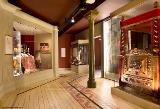| Presentationstext <itemDescription> |
-
BILD. Vy över Göteborg, kopparstick från 1690-talet (Petter Geddas sjöatlas, Statens maritima museer)
-
BEFÄSTNINGEN SKANSEN LEJONET. I slutet av 1600-talet var Göteborg en av Europas bäst skyddade st...
Visa hela
BILD. Vy över Göteborg, kopparstick från 1690-talet (Petter Geddas sjöatlas, Statens maritima museer)
-
BEFÄSTNINGEN SKANSEN LEJONET. I slutet av 1600-talet var Göteborg en av Europas bäst skyddade städer. I Haga och Gullbergsvass reser sig fortfarande skansarna Kronan och Lejonet (Västgöta Lejon) på sina kullar.
VALLGRAV OCH KANALER. 1600-talets Göteborg omges av en vallgrav, och genom staden går flera kanaler. På 18- och 1900-talen fylls det mesta igen, men fortfarande finns Stora Hamnkanalen, Fattighuskanalen och delar av vallgraven kvar.
KRONHUSET är Göteborgs bäst bevarade hus från 1600-talet. Det byggs som förråd åt militären. Det tar mer än tio år att få huset klart, år 1654 är det färdigt.
TYSKKA KYRKAN. När guvenören Rutger von Ascheberg flyttar till Göteborg, låter han bygga ett särsklit utrymme i änden på Tyska kyrkan. Där ska han och hans familj begravas. Utrymmet kallas gravkor och är klart år 1682. Kyrkan har brunnit sedan dess, men gravkoret har klarat sig. Där går det ännu att se familjens kistor.
RAKA GATOR OCH KVARTER. Göteborg byggs med raka gator och kvarter. Det är en struktur som fortfarande går att se i den gamla innerstaden. Södra och Östra Larmgatan visar var husen slutade och muren började.
RESIDENSET. På Södra Hamngatan 1 låter guvenör Lennart Torstensson bygga ett hus omkring år 1650. Sedan dess har huset byggts om många gånger, men mycket är sig fortfarande likt. Idag kallas huset Residenset, och där bor landshövdingen i Västra Götaland. En takmålning från 1600-talet finns i Residenset, som visar antika myter.
GÖTEBORGS DOMKYRKA / SVENSKA KYRKAN är den tredje domkyrkan på samma plats. Den första "Gustavi domkyrka" invigdes 1633 året efter Gustav II Adolfs död, i slaget vid Lützen.
MURARNA. I slutet av 1600-talet är Göteborg en av Europas bäst skyddade städer, med höga murar. På 1800-talet blir murarna omoderna och det mesta rivs. Idag finns det bara delar kvar, som bastionen vid Esperantoplatsen.
----------
Stäng
|
| Presentation text / english <itemDescription> |
-
Most of 1600s Gothenburg has gone but som buildings and other traces from the city's first century do remain.
-
IMAGE. View of Gothenburg, copperplate from the 1690s. (Petter Geddas sjöatlas, The Swed...
Visa hela
Most of 1600s Gothenburg has gone but som buildings and other traces from the city's first century do remain.
-
IMAGE. View of Gothenburg, copperplate from the 1690s. (Petter Geddas sjöatlas, The Swedish National Maritime Museums)
-
MOAT AND CANALS. 1600s Gothenburg was surrounded by a moat and several canals ran through the city. In the 18- and 1900s most of this was filled in but Stora Hamnkanalen (Graet Harbour Canal), Fattighuskanalen (Poorhouse Canal) and parts of the moat still remain.
KRONHUSET is Gothenburg's best-preserved building from the 1600s. It was buitl as a military storehouse. It took over ten years to built and was finished in 1654.
THE GERMAN CHURCH. When Governor Rutger von Ascheberg moved to Gothenburg he ordered the construction of a special space at the end of the German Church. There he and his family would be buried. The space is called a burial chapel and was finished in 1682. Subsequently the church was almost totally destroyed by fire and had to be rebuilt but the burial chapel survived. The family's coffins can still be seen there.
STRAIGHT STREETS AND BLOCKS. Gothenburg was built with straight streets and rectangular city blocks. This layout can still be seen in the old city centre. Södra and Östra Larmgatan streets mark where the buildings stopped and the wall began.
THE RESIDENCE. In about 1650 Governor Lennart Torstensson had a house built at Södra Larmgatan 1. Since then the building has been rebuilt many times but much of its original appearance still remains. Today it is called Residenset (the Residence), and is the official residence of the Governor of Västra Götaland County. In the Residence there is a painted ceiling from the 1600s. The painting shows scenes from classical mythology.
GOTHENBURG CATHEDRAL / THE SWEDISH CHURCH is the third cathedral in the same place. The first "Gustavi Cathedral" was consecrated in 1633, the year after the death of Gustav II Adolf at the Battle of Lützen.
THE WALLS. At the end of the 1600s Gothenburg with its high walls was one of Europe's best-protected cities. In the 1800s the walls became outdated and were mostly torn down. Today only sections remain, such as the bastion at Esperantoplatsen.
Stäng
|


 ARTIKLAR I WIKIPEDIA
ARTIKLAR I WIKIPEDIA ARTIKLAR I WIKIDATA
ARTIKLAR I WIKIDATA BILDER I WIKIMEDIA COMMONS
BILDER I WIKIMEDIA COMMONS



